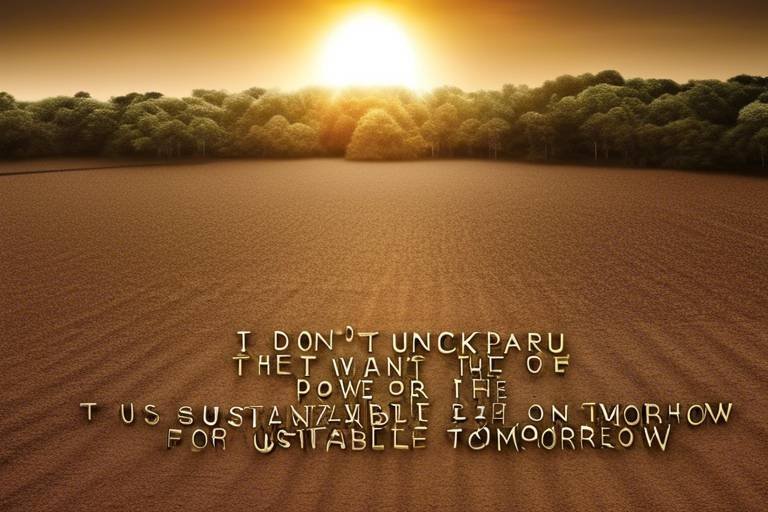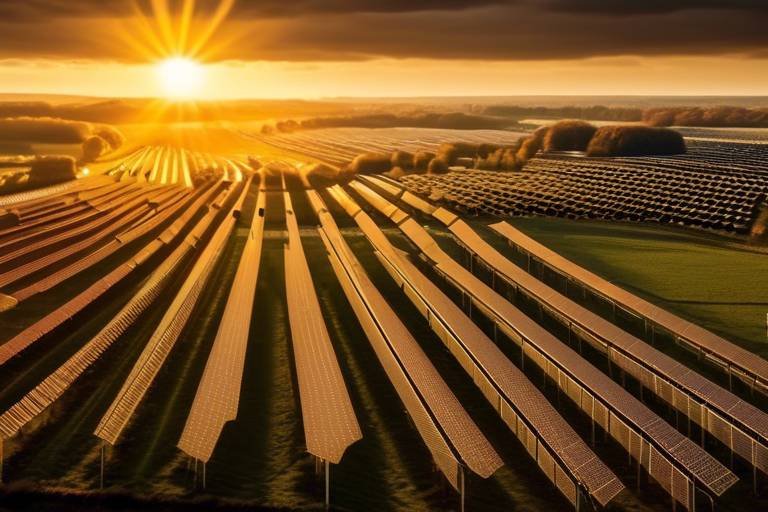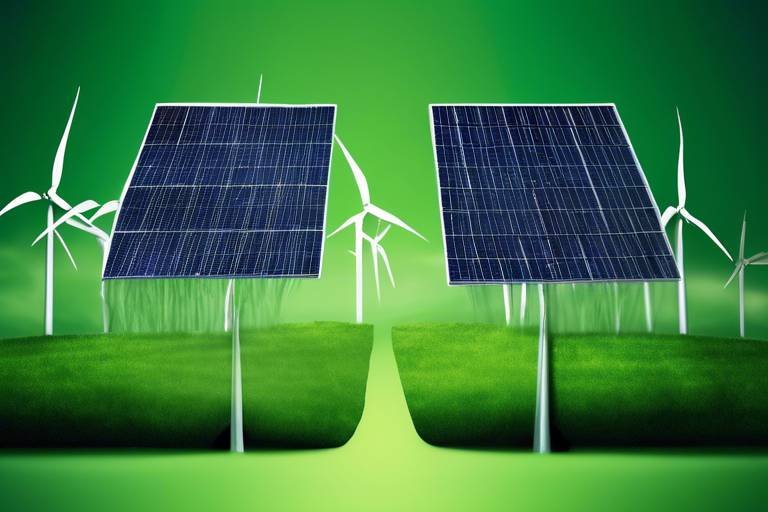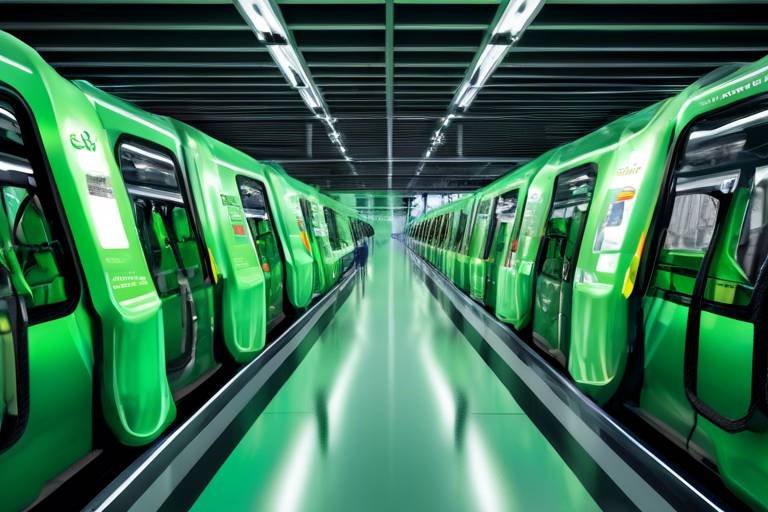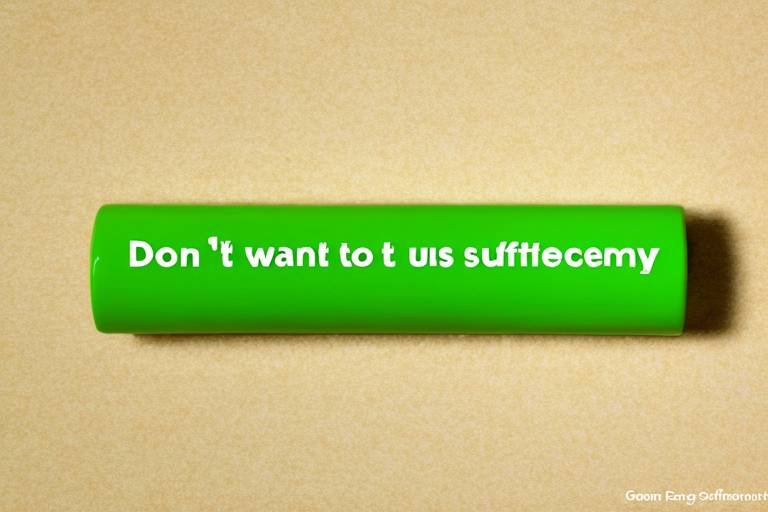Can Green Energy Power Entire Cities?
Imagine a world where cities are not just bustling hubs of activity but also shining examples of sustainability and innovation. The question on many minds today is: Can green energy truly power entire cities? With the growing urgency to combat climate change and reduce our carbon footprint, the shift towards renewable energy sources has never been more critical. From solar panels glistening on rooftops to wind turbines spinning gracefully on the horizon, the potential of green energy to transform urban landscapes is both exciting and daunting.
As we delve into this topic, we will explore the various types of renewable energy sources that are gaining traction, such as solar, wind, and hydroelectric power. These sources are not just alternatives; they are becoming integral components of the global energy landscape. In fact, many cities are already harnessing these resources to create cleaner, more sustainable environments for their residents. But is it enough to say that these technologies can power entire urban areas? The answer lies in understanding the innovations, policies, and challenges associated with this transition.
Throughout this article, we will examine the technological advancements that are making green energy solutions more efficient and scalable. We'll discuss the role of smart grids and energy storage systems, which are essential for managing the flow of renewable energy in urban settings. Furthermore, we will highlight microgrid systems, which serve as localized energy networks capable of operating independently, ensuring resilience and reliability. Together, these elements form a robust framework that could enable cities to thrive on green energy.
However, it's not all sunshine and rainbows. Transitioning to green energy comes with its own set of challenges, including financial hurdles, infrastructural limitations, and the need for supportive government policies. We will dive into these obstacles and explore how cities can overcome them to realize their green energy ambitions. By analyzing successful case studies from around the world, we will showcase innovative strategies that have made a positive impact on communities.
Ultimately, the journey towards fully powered green cities is a collective endeavor that requires collaboration among governments, businesses, and citizens. As we navigate through the complexities of this transition, one thing is clear: the potential for green energy to power entire cities is not just a dream; it is a possibility that is becoming increasingly tangible. So, can green energy power entire cities? The answer is not just a simple yes or no; it is a resounding yes—if we are willing to embrace the challenges and seize the opportunities that lie ahead.
- What types of renewable energy are most commonly used in cities? Solar, wind, and hydroelectric power are the most prevalent forms of renewable energy powering urban areas.
- How do smart grids work? Smart grids utilize digital technology to monitor and manage the distribution of electricity, improving efficiency and reliability.
- What are microgrids? Microgrids are localized energy networks that can operate independently or in conjunction with the main grid, enhancing energy resilience.
- What challenges do cities face in adopting green energy? Major challenges include financial constraints, infrastructure needs, and regulatory hurdles.
- Can public awareness influence green energy initiatives? Yes, increased public awareness and education can drive community support for green energy projects.

The Rise of Renewable Energy Sources
In recent years, the world has witnessed a remarkable shift towards renewable energy sources, driven by the urgent need to combat climate change and reduce our reliance on fossil fuels. This transformation is not just a fleeting trend; it represents a fundamental change in how we think about energy production and consumption. With the growing awareness of environmental issues, cities around the globe are beginning to embrace sustainable energy solutions that promise to power urban areas in a cleaner, more efficient manner.
So, what exactly are these renewable energy sources? They primarily include solar energy, wind power, and hydroelectric power. Each of these sources has its unique characteristics and benefits:
| Energy Source | Description | Advantages |
|---|---|---|
| Solar Energy | Harnessing sunlight through solar panels. | Abundant, reduces electricity bills, low maintenance. |
| Wind Power | Utilizing wind turbines to convert wind energy into electricity. | Clean, renewable, and cost-effective in suitable locations. |
| Hydroelectric Power | Generating power through the flow of water in rivers or dams. | Reliable, efficient, and can provide large-scale energy. |
As cities strive to reduce their carbon footprints, the importance of these renewable resources cannot be overstated. For instance, solar energy has become increasingly popular due to its versatility; it can be installed on rooftops, integrated into building designs, or utilized in solar farms. Wind energy, on the other hand, is particularly effective in areas with strong and consistent winds, making it a viable option for coastal and open plains regions.
Moreover, hydroelectric power remains one of the most established forms of renewable energy. It provides a steady and reliable source of electricity, particularly in areas with abundant water resources. The growth of these energy sources is not merely a response to environmental challenges; it is also driven by technological advancements that have made them more accessible and affordable. For example, the cost of solar panels has plummeted in recent years, allowing more households and businesses to invest in solar energy systems.
Additionally, the shift towards renewable energy is supported by government policies and incentives aimed at promoting clean energy adoption. Many countries are implementing tax credits, grants, and subsidies to encourage the development of renewable energy projects. This not only helps to stimulate local economies but also paves the way for a more sustainable future.
However, the rise of renewable energy sources is not without its challenges. Issues such as energy storage, grid integration, and the need for improved infrastructure must be addressed to fully realize the potential of these technologies. As urban areas continue to grow, the demand for energy will only increase, making it imperative that we invest in solutions that can meet this demand sustainably.
In conclusion, the rise of renewable energy sources marks a pivotal moment in our quest for a sustainable future. By embracing technologies like solar, wind, and hydroelectric power, cities can not only reduce their environmental impact but also create resilient energy systems that stand the test of time. Are we ready to make this leap into a cleaner, greener world?

Technological Innovations in Green Energy
In recent years, the landscape of green energy has been transformed by rapid technological innovations that not only enhance efficiency but also make renewable sources more scalable and accessible. Imagine a world where the sun, wind, and water are not just natural elements but powerful allies in our quest for sustainable living. This is no longer a distant dream; it’s becoming a reality thanks to groundbreaking advancements in technology. From solar panels that can generate energy even on cloudy days to wind turbines that harness the power of even the slightest breeze, the innovations in this sector are nothing short of revolutionary.
One of the most significant advancements has been in the realm of smart grids. These sophisticated networks utilize digital technology to monitor and manage the transport of electricity from all generation sources to meet the varying electricity demands of end-users. Unlike traditional grids, smart grids allow for two-way communication between the utility and its customers, which means that energy can be distributed more efficiently and can adapt to real-time usage patterns. This adaptability is crucial for urban areas where energy demands fluctuate significantly throughout the day.
But what good is a smart grid without effective energy storage solutions? This is where battery technologies come into play. Recent developments in battery storage are paving the way for a more reliable energy supply. For instance, advancements in lithium-ion batteries have made them cheaper and more efficient, allowing for larger-scale storage of renewable energy. This means that energy generated during the day can be stored and used at night, ensuring a continuous power supply. Imagine charging your phone during the day with solar energy and using that energy later at night—this is the future of energy storage!
Moreover, innovations like solid-state batteries and flow batteries are emerging as game-changers. Solid-state batteries, which replace the liquid electrolyte with a solid one, promise to deliver higher energy densities and greater safety. Flow batteries, on the other hand, offer the ability to scale up energy storage capacity simply by increasing the size of the tanks that hold the electrolyte solution. These technologies are crucial for cities that are looking to maximize their renewable energy usage while minimizing reliance on fossil fuels.
Another exciting development in the green energy sector is the rise of microgrid systems. These localized energy networks can operate independently or in conjunction with the main grid. Microgrids enhance resilience, especially during natural disasters or power outages, by allowing communities to generate and manage their own energy. Think of them as energy islands that can sustain themselves. Cities like San Diego and Brooklyn are already implementing microgrids, showcasing how they can provide reliable power while integrating renewable sources like solar and wind energy.
As we explore these innovations, it’s clear that the future of urban energy is not just about generating power but doing so in a way that is smart, efficient, and sustainable. The integration of smart grids, advanced battery technologies, and microgrid systems is setting the stage for cities to become more self-sufficient and less reliant on non-renewable resources. It’s an exciting time for green energy, and the innovations we are witnessing today will shape the cities of tomorrow.

Smart Grids and Energy Storage
In the quest to power entire cities with green energy, smart grids and energy storage systems have emerged as the backbone of this ambitious endeavor. Imagine a city where energy flows as smoothly as water in a river, adapting to the needs of its inhabitants in real-time. Smart grids are essentially the nervous system of modern energy distribution—they are intelligent networks that manage and distribute energy efficiently, ensuring that every watt generated from renewable sources is utilized optimally.
At the heart of smart grids is the ability to monitor energy consumption and production dynamically. This technology allows for two-way communication between energy providers and consumers, creating a more responsive and resilient energy ecosystem. For instance, during peak demand times, smart grids can adjust the energy distribution to prioritize critical services, ensuring that hospitals and emergency services receive the power they need without interruption.
Now, let’s talk about the role of energy storage systems. These systems are crucial because renewable energy sources like solar and wind are inherently intermittent. The sun doesn’t always shine, and the wind doesn’t always blow. Energy storage acts like a sponge, soaking up excess energy generated during peak production times and releasing it when demand spikes. This capability is vital for maintaining a consistent power supply, especially in urban areas with fluctuating energy needs.
Recent advancements in battery technologies, such as lithium-ion and emerging solid-state batteries, have significantly enhanced the capacity and efficiency of energy storage systems. These innovations not only improve the lifespan and performance of batteries but also reduce costs, making them more accessible for widespread use. For example, a city could deploy a network of battery storage units that charge during the day when solar energy is abundant and discharge during the evening when demand peaks. This model not only stabilizes the grid but also maximizes the use of renewable resources.
| Battery Type | Advantages | Challenges |
|---|---|---|
| Lithium-Ion | High energy density, long lifespan | Resource-intensive production, recycling issues |
| Solid-State | Safer, higher energy density | Still in development, high production costs |
| Flow Batteries | Long cycle life, scalable | Lower energy density, complex systems |
Furthermore, microgrid systems complement smart grids and energy storage by creating localized energy networks. Think of them as mini power plants that can operate independently or in conjunction with the main grid. Microgrids can be particularly beneficial in urban settings, providing a reliable energy source during outages or emergencies. They can harness local renewable resources, such as solar panels on rooftops or wind turbines in parks, and distribute this energy directly to nearby consumers. This not only enhances energy security but also promotes community engagement in sustainable practices.
As we move towards a greener future, the integration of smart grids and energy storage systems will be pivotal. They offer a pathway to harnessing the full potential of renewable energy, making it possible for cities to transition from traditional fossil fuels to sustainable energy sources. The combination of these technologies not only supports energy independence but also contributes to a cleaner, healthier environment for generations to come.

Battery Technologies
When we talk about green energy, one of the unsung heroes in this narrative is undoubtedly battery technology. Imagine trying to fill a bathtub with water but having a drain that just won't stop leaking. That’s what it’s like trying to harness renewable energy without effective storage solutions. Batteries are the key to solving this problem, allowing us to store energy generated from sources like solar and wind for use when the sun isn’t shining or the wind isn’t blowing. Recent advancements in battery technologies are paving the way for a more sustainable future, making it possible for entire cities to rely on renewable energy.
One of the most promising developments in this field is the evolution of lithium-ion batteries. These batteries are not only more efficient but also have a longer lifespan compared to traditional lead-acid batteries. They are commonly used in electric vehicles and portable electronics, but their potential for grid storage is what makes them a game-changer. As cities push towards greener initiatives, the demand for reliable battery storage solutions is skyrocketing. In fact, many experts believe that the next decade will see a significant decrease in battery costs, making them more accessible for large-scale energy storage.
Moreover, innovations like solid-state batteries are on the horizon. These batteries promise to deliver even greater energy density and safety compared to their liquid counterparts. With the ability to pack more energy into a smaller space, solid-state batteries could revolutionize how we store energy in urban environments. Imagine a city where energy storage is not just a backup plan but a primary method of energy management!
As we explore the various battery technologies available today, it’s essential to consider their environmental impact. Many manufacturers are now focusing on creating batteries that are not only efficient but also recyclable and made from sustainable materials. This shift is crucial because it addresses the growing concern over battery waste and the need for a circular economy in the energy sector.
In terms of practical application, cities are beginning to implement battery storage systems as part of their energy infrastructure. For instance, cities like San Diego and Amsterdam are investing heavily in battery storage to complement their renewable energy initiatives. These cities are not just relying on traditional energy sources; they are actively integrating battery systems to store excess energy, which can be distributed during peak demand times. This approach not only enhances the reliability of the energy supply but also stabilizes energy prices.
To further illustrate the impact of battery technologies, consider the following table showcasing different types of batteries and their applications:
| Battery Type | Energy Density (Wh/kg) | Typical Applications |
|---|---|---|
| Lithium-Ion | 150-250 | Electric vehicles, grid storage |
| Solid-State | 300-500 (projected) | Consumer electronics, electric vehicles |
| Lead-Acid | 30-50 | Backup power, older electric vehicles |
| Flow Batteries | 20-40 | Grid storage, renewable energy integration |
In conclusion, battery technologies are not just a supporting act in the green energy play; they are becoming the lead performers. As advancements continue to emerge, we can expect to see a significant transformation in how cities harness and utilize renewable energy. With the right investment and innovation, the dream of powering entire cities with green energy is not just a possibility; it’s becoming a reality.
- What are battery technologies? Battery technologies refer to the various systems and innovations used to store electrical energy for later use, particularly from renewable sources.
- Why are batteries important for green energy? Batteries store excess energy generated from renewable sources, allowing for consistent power supply even when generation is low.
- What is the future of battery technology? The future of battery technology looks promising with advancements in solid-state batteries and recycling methods that enhance sustainability.

Microgrid Systems
Microgrid systems are like the unsung heroes of the green energy revolution. Imagine a small, self-sufficient energy network that can operate independently from the larger grid. These systems are designed to generate, distribute, and regulate energy locally, making them incredibly versatile and resilient. In urban areas, where energy demands can fluctuate wildly, microgrids serve as a safety net, ensuring that communities have reliable power even in the face of outages or disruptions from the main grid.
One of the most exciting aspects of microgrid systems is their ability to integrate various renewable energy sources. Picture a neighborhood where solar panels on rooftops, wind turbines in nearby parks, and even biogas from local farms all come together to create a sustainable energy ecosystem. This synergy not only reduces reliance on fossil fuels but also empowers communities to take control of their energy needs. With the right technology in place, excess energy generated can be stored and used during peak demand times, ensuring a steady and reliable power supply.
Moreover, microgrids can enhance energy security. In times of crisis, such as natural disasters or cyber-attacks, these localized networks can isolate themselves from the larger grid, protecting them from external threats. This independence is crucial for cities looking to bolster their resilience against climate change and other unforeseen challenges. For instance, during Hurricane Sandy in 2012, microgrid systems in New York City demonstrated their value by keeping critical facilities like hospitals and emergency services powered when the larger grid failed.
However, implementing microgrid systems comes with its own set of challenges. Cities must navigate regulatory hurdles, secure funding, and ensure community buy-in. It’s not just about technology; it’s about people and policies working hand in hand. Fortunately, as awareness of the benefits of microgrids grows, so does the support from government entities and private investors. They recognize that investing in these systems is not just a step towards sustainability but also a leap toward energy independence.
In summary, microgrid systems represent a pivotal shift in how we think about energy distribution in urban settings. They are not just a backup plan; they are a proactive approach to creating resilient, sustainable cities. With ongoing advancements in technology and increasing public support, the future of urban energy could very well be powered by microgrids, leading us to a greener, more self-sufficient tomorrow.
- What are microgrid systems? Microgrid systems are localized energy networks that can operate independently, integrating various renewable energy sources to provide reliable power.
- How do microgrids enhance energy security? They can isolate themselves from the larger grid during crises, ensuring that critical services remain powered even when the main grid fails.
- What challenges do cities face in implementing microgrids? Cities must navigate regulatory issues, secure funding, and ensure community support to successfully implement microgrid systems.
- Can microgrids operate on renewable energy alone? Yes, microgrids can be designed to rely solely on renewable sources such as solar, wind, and biogas, promoting sustainability.

Policy and Government Support
When it comes to transitioning to green energy, the role of government policies and support cannot be overstated. Just imagine trying to bake a cake without a recipe; you might get something edible, but it’s unlikely to be a masterpiece. Similarly, without a solid framework of policies, cities may struggle to effectively implement renewable energy solutions. Governments around the world are beginning to recognize the importance of renewable energy and are taking steps to create an environment that fosters innovation and investment in this sector.
One of the most impactful ways governments can support green energy initiatives is through incentives and subsidies. These financial aids can significantly reduce the cost burden on both businesses and consumers, making it easier for them to adopt renewable technologies. For example, tax credits for solar panel installations or grants for wind energy projects can drive substantial growth in these areas. Moreover, these incentives can help to level the playing field against traditional fossil fuels, which have historically enjoyed extensive subsidies.
In addition to financial support, governments can also play a crucial role in setting ambitious renewable energy targets. By establishing clear goals, such as achieving 100% renewable energy by a certain year, cities can rally both public and private sectors around a common mission. This not only encourages investment but also fosters innovation as companies and researchers strive to meet these targets. For instance, cities like San Diego and Copenhagen have set their sights on ambitious sustainability goals, leading to significant advancements in their green energy infrastructure.
Furthermore, regulatory frameworks are essential for ensuring that green energy projects can be implemented smoothly and efficiently. This includes streamlining permitting processes, creating clear guidelines for energy production, and ensuring that there is a stable grid infrastructure to support renewable energy sources. Without these frameworks, potential projects may face unnecessary delays or even be canceled altogether due to bureaucratic red tape.
To illustrate the impact of government support, let’s look at a few key examples:
| City | Policy/Support | Impact |
|---|---|---|
| San Diego | 100% renewable energy goal by 2035 | Increased solar installations, reduced carbon emissions |
| Copenhagen | Investment in wind energy and cycling infrastructure | Leading global city in sustainability, reduced traffic congestion |
| Reykjavik | Geothermal energy utilization | 100% renewable heating and electricity |
Lastly, public engagement and education are vital components of successful policy implementation. When citizens understand the benefits of green energy and how it affects their lives, they are more likely to support initiatives and participate in programs. Governments can promote awareness through campaigns, workshops, and community events, creating a culture of sustainability that empowers individuals to make informed choices.
In conclusion, the path to a greener future is paved with robust policies and unwavering government support. By providing incentives, setting ambitious targets, crafting effective regulations, and engaging the public, cities can not only transition to green energy but do so in a way that benefits everyone involved. The journey may be challenging, but with the right support in place, the destination is within reach.

Challenges to Implementing Green Energy
Transitioning to green energy is like setting sail on a vast ocean; while the destination promises a cleaner, more sustainable future, the journey is fraught with challenges that can make even the sturdiest ship wobble. One of the most significant hurdles is the financial investment required to make this shift. Cities often grapple with tight budgets, and the upfront costs of renewable energy technologies can seem daunting. However, it's important to remember that these investments can lead to long-term savings and environmental benefits.
Moreover, the infrastructure needed to support renewable energy sources is often outdated. Many urban areas were built around fossil fuels, and retrofitting them to accommodate solar panels, wind turbines, and other green technologies can be a logistical nightmare. This is where government support and innovative funding solutions come into play, providing the necessary resources to modernize our cities.
Regulatory challenges also pose a significant barrier. Policies regarding energy production and distribution can vary widely from one region to another, creating a patchwork of regulations that complicate the implementation of green energy initiatives. Local governments must navigate these regulations carefully to ensure compliance while also striving to meet ambitious sustainability goals.
Public acceptance is another critical factor that can’t be overlooked. While many people are enthusiastic about the idea of green energy, there can be resistance to specific projects, especially if they impact local landscapes or communities. Education and awareness campaigns can play a vital role in overcoming this resistance. By informing the public about the benefits of renewable energy and involving them in the decision-making process, cities can foster a sense of ownership and support for green initiatives.
In summary, the path to implementing green energy is not without its obstacles. Cities must tackle financial, infrastructural, regulatory, and social challenges head-on. Yet, with determination, innovation, and community engagement, the transition to a greener future can become a reality. The journey may be tough, but the destination is worth every effort.
- What are the main challenges cities face in adopting green energy?
Cities often struggle with financial investment, outdated infrastructure, regulatory hurdles, and public acceptance. - How can governments support the transition to green energy?
Governments can provide financial incentives, create supportive policies, and invest in infrastructure improvements. - Why is public acceptance important for green energy projects?
Public support can drive successful implementation and ensure that projects meet community needs and preferences.

Financial Investment and Funding
The transition to green energy is not just a technological shift; it's a financial revolution. Cities aiming to harness the power of renewable resources must grapple with the reality that substantial financial investment is required to kickstart these initiatives. The costs associated with installing solar panels, wind turbines, and other renewable energy systems can be daunting. However, the long-term savings and environmental benefits often outweigh the initial expenditure. But how do cities secure the necessary funding to make this leap?
One of the most promising avenues for financing green energy projects is through public-private partnerships. These collaborations can significantly alleviate the financial burden on municipalities. By partnering with private companies, cities can access not only capital but also expertise in implementing renewable energy solutions. For instance, a city might collaborate with a solar provider to install solar panels on public buildings, sharing both the costs and the profits generated from energy savings.
Moreover, many governments are beginning to offer incentives and grants to encourage the adoption of green technologies. These financial incentives can take various forms, including tax credits, rebates, and low-interest loans. For example, a city that invests in a wind farm might receive a tax credit that offsets a portion of the initial investment, making the project more financially feasible. The table below illustrates some common funding sources available for green energy projects:
| Funding Source | Description | Potential Benefits |
|---|---|---|
| Government Grants | Financial assistance provided by governmental bodies for specific projects. | Reduces upfront costs, enhances project viability. |
| Tax Incentives | Reductions in tax liabilities for investments in renewable energy. | Improves return on investment, encourages more projects. |
| Green Bonds | Debt securities issued to raise funds for climate-related projects. | Access to capital markets, often at lower interest rates. |
| Private Investments | Funding from private investors or venture capital for renewable projects. | Brings innovation and expertise, accelerates project timelines. |
Yet, it's not just about securing funds; cities must also demonstrate a clear return on investment to attract potential investors. This means conducting thorough feasibility studies and showcasing how these projects can lead to job creation, energy savings, and reduced carbon emissions. By presenting a comprehensive business case, cities can effectively communicate the long-term benefits of green energy investments to both public and private stakeholders.
Furthermore, community involvement plays a crucial role in funding green energy initiatives. When residents are engaged in the planning and implementation processes, they are more likely to support funding measures such as local bonds or taxes dedicated to renewable energy projects. This communal approach not only fosters a sense of ownership but also enhances public acceptance, which is essential for the sustainability of these initiatives.
In conclusion, while the financial challenges of transitioning to green energy are significant, they are not insurmountable. Through innovative funding strategies, public-private partnerships, and community engagement, cities can unlock the potential of renewable energy and pave the way for a more sustainable future. The journey may be complex, but the rewards—both environmental and economic—are well worth the investment.

Public Acceptance and Awareness
When it comes to the adoption of green energy, one of the biggest hurdles isn't just about technology or investment—it's about the people. Public acceptance and awareness play a crucial role in the successful implementation of renewable energy initiatives. Think of it this way: if a city decides to go green but the residents are skeptical or uninformed, the whole effort can feel like trying to push a boulder uphill. The key to overcoming this challenge lies in effective communication and community engagement.
Education is the cornerstone of public acceptance. When people understand the benefits of green energy—such as reduced carbon emissions, lower utility bills, and improved public health—they're more likely to support these initiatives. Awareness campaigns that highlight these advantages can significantly shift public opinion. For instance, cities can host workshops, create informative websites, and use social media to spread the word. By making information accessible and engaging, cities can foster a culture of sustainability among their residents.
Moreover, community involvement is essential. When residents feel like they have a stake in the transition to green energy, they are more likely to embrace it. Engaging local communities in the planning and implementation phases can lead to better outcomes. For example, cities can establish community advisory boards that include residents, business owners, and environmental activists. This collaborative approach not only builds trust but also ensures that the solutions implemented meet the unique needs of the community.
Surprisingly, the emotional aspect of public acceptance cannot be overlooked. People tend to support initiatives that resonate with their values and beliefs. Therefore, storytelling can be a powerful tool. Sharing success stories from other cities or highlighting local heroes who are champions of green energy can inspire others to join the movement. When residents see their neighbors benefiting from renewable energy, they're more likely to jump on the bandwagon.
However, it’s not just about spreading positivity. Addressing concerns and misconceptions is equally important. Some residents may fear that transitioning to green energy could lead to job losses in traditional energy sectors or increased costs. Cities need to be transparent about the transition process and provide reassurances that jobs will be created in new sectors and that investments in green technologies will ultimately save money in the long run. A well-informed public is less likely to resist change.
To summarize, public acceptance and awareness are critical components in the journey toward a greener future. By prioritizing education, community involvement, emotional engagement, and transparent communication, cities can pave the way for a successful transition to renewable energy. The more informed and involved the public is, the smoother the transition will be, transforming skepticism into enthusiastic support.
- Why is public awareness important for green energy projects?
Public awareness helps to build support for green energy initiatives, ensuring that residents understand the benefits and are willing to participate in the transition. - How can cities increase public awareness about green energy?
Cities can use workshops, social media campaigns, and community events to educate residents about the advantages of renewable energy. - What role does community involvement play in green energy initiatives?
Community involvement fosters trust and ensures that initiatives meet the needs of residents, leading to greater acceptance and support.

Case Studies: Cities Leading the Way
As the world shifts towards a more sustainable future, several cities have emerged as pioneers in the implementation of green energy solutions. These cities have not only embraced renewable energy but have also showcased how innovative strategies can lead to significant environmental and economic benefits. Let's take a closer look at some of these trailblazers.
One prime example is San Diego, California. This city has set an ambitious goal to achieve 100% renewable energy by 2035. Through a combination of solar power installations, wind energy, and energy efficiency programs, San Diego is making impressive strides. The city has implemented an extensive network of solar panels on rooftops and public spaces, significantly reducing its carbon footprint. Moreover, the local government has incentivized residents to adopt solar technology, creating a community that is both environmentally conscious and economically savvy.
Meanwhile, Stockholm, Sweden, has been recognized for its innovative approach to urban sustainability. The city has integrated a comprehensive public transport system powered by biofuels and electricity, reducing reliance on fossil fuels. Stockholm's “Green City” initiative has also seen the introduction of green roofs and energy-efficient buildings, making it a model for urban planning. The city aims to be fossil fuel-free by 2040, and its commitment to green energy is evident in its policies and community engagement.
Across the globe, Freiburg, Germany, stands out as a beacon of sustainability. Known for its pioneering solar energy projects, Freiburg has transformed into a solar capital. The city encourages residents to install solar panels and has invested heavily in renewable energy infrastructure. Additionally, Freiburg's public transportation system is designed to minimize emissions, with a robust network of trams and bicycles promoting eco-friendly mobility. The success of Freiburg highlights the importance of community involvement and government support in achieving green energy goals.
In Asia, Masdar City in the United Arab Emirates is a remarkable example of a sustainable urban environment. Designed as a zero-carbon city, Masdar utilizes cutting-edge technology to harness solar energy and wind power. The city features a unique “car-free” design, encouraging walking and the use of electric vehicles. Masdar City not only serves as a model for future urban developments but also demonstrates the potential of green energy in arid regions.
These case studies illustrate that transitioning to green energy is not just a dream but a reality achievable through collaboration, innovation, and commitment. Each city showcases unique strategies tailored to their specific needs and challenges, proving that there is no one-size-fits-all solution. Instead, a combination of local resources, community engagement, and strong policy frameworks can lead to successful green energy implementations.
As we look towards the future, it's clear that the lessons learned from these cities can guide others in their journey towards sustainability. By sharing best practices and fostering international cooperation, cities around the world can harness the power of green energy to create healthier, more resilient communities.
- What are the main benefits of transitioning to green energy?
Transitioning to green energy reduces greenhouse gas emissions, lowers energy costs, and promotes energy independence. - How can cities finance their green energy projects?
Cities can explore public-private partnerships, government grants, and innovative funding solutions to support their renewable energy initiatives. - What role do citizens play in promoting green energy?
Citizens can advocate for sustainable policies, participate in community programs, and adopt renewable technologies in their homes.
Frequently Asked Questions
- Can green energy really power an entire city?
Absolutely! Many cities around the world are already using green energy sources like solar, wind, and hydroelectric power to meet their energy needs. With advancements in technology and energy storage solutions, it's becoming increasingly feasible for urban areas to rely entirely on renewable energy.
- What are the main types of renewable energy?
The main types of renewable energy include solar power, wind energy, hydroelectric power, geothermal energy, and biomass. Each of these sources has its own unique benefits and can contribute to a sustainable energy mix for cities.
- How do smart grids enhance the use of green energy?
Smart grids use digital technology to monitor and manage energy flows, allowing for more efficient distribution of renewable energy. They can balance supply and demand in real-time, integrate various energy sources, and improve reliability, making them essential for cities transitioning to green energy.
- What role do battery technologies play in green energy?
Battery technologies are crucial for storing energy generated from renewable sources. They allow cities to store excess energy produced during peak generation times (like sunny or windy days) and use it when demand is high, ensuring a steady and reliable power supply.
- What are microgrid systems?
Microgrid systems are localized energy networks that can operate independently or in conjunction with the main grid. They provide resilience and reliability, especially during outages, and can be powered by renewable sources, making them an excellent solution for cities focused on sustainability.
- What challenges do cities face when implementing green energy?
Cities encounter several challenges when transitioning to green energy, including financial constraints, infrastructural limitations, and regulatory hurdles. Addressing these obstacles requires innovative funding solutions, supportive policies, and public engagement.
- How important is public awareness in adopting green energy?
Public awareness plays a significant role in the successful implementation of green energy initiatives. When communities understand the benefits of renewable energy, they are more likely to support and engage in sustainable practices, making education and outreach essential.
- Are there cities that have successfully transitioned to green energy?
Yes! Cities like San Diego, Copenhagen, and Reykjavik have made significant strides in adopting green energy solutions. These case studies showcase innovative strategies and the positive impacts on their communities, serving as models for other urban areas.


